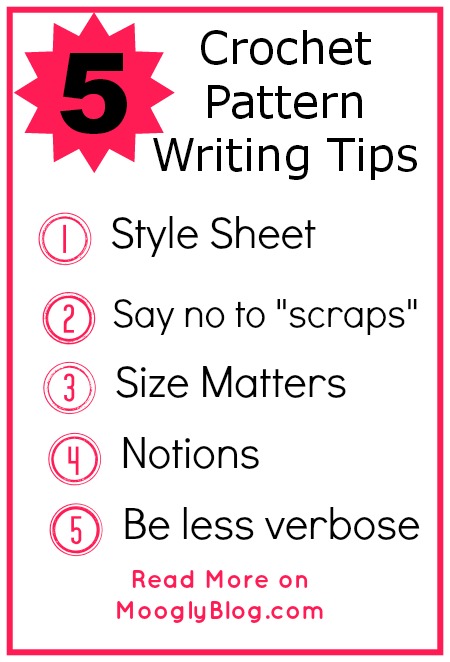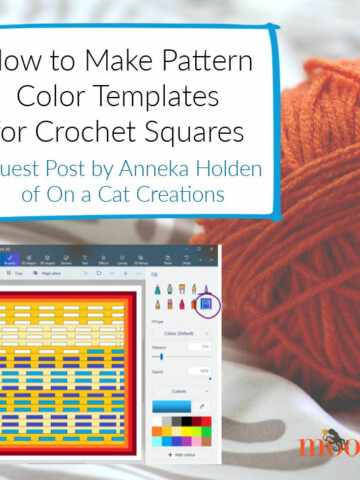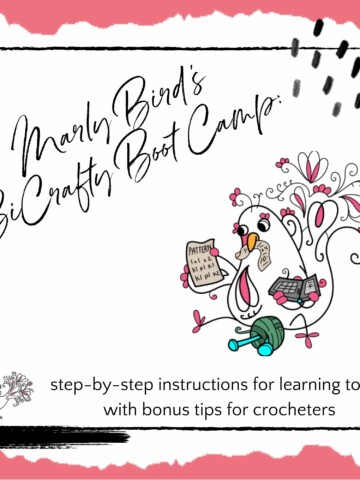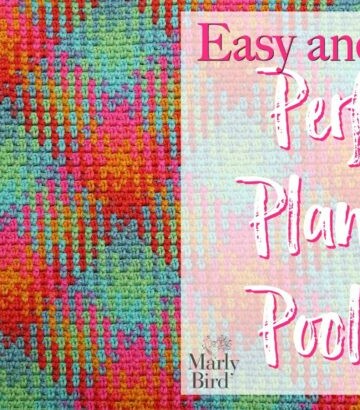As I prep for the Thanksgiving holiday this week, I'm thankful for this guest post by Sara Duggan! Sara is a crochet designer, blogger, and author of several eBooks aimed at helping people get started and make a success of their crochet businesses, the latest of which is a joint work titled Create Crochet Patterns (update - this book is no longer available to the best of my knowledge)! Here's what Sara has to share with budding designers about writing crochet patterns! - Tamara
5 Things I Learned About Writing Crochet Patterns from My Tech Editor

I started writing patterns in 2008. It wasn’t until recently that I hired a tech editor. What’s a tech editor? She/He is someone who proofreads, checks math, streamlines, corrects, and basically makes it so your pattern is consistent throughout.
When creating patterns I usually make a prototype while taking notes. (See Testing Patterns in 5 Easy Steps) I then type the pattern. I make another sample following the pattern and if everything goes well I publish it.
Now just because this is the way I did it doesn’t mean you should. I am using myself as an example to warn against assuming you will catch all mistakes.
Eventually I started having other crocheter’s test my patterns. This helped a little but still my patterns were missing uniformity. In one pattern I would write – slip stitch – and in another pattern I would write – sl st – and still in another one I would write –slst-. A tech editor would catch this and correct it.
After Working with a Tech Editor This is what I Learned:
Use a Stylesheet – these are helpful for the editor, for you, and for the person making the pattern. These are unique to the designer or publisher. You want the same stylesheet for each pattern you create. (Example: Planet June's Stylesheet)
Stop Using ‘Scrap’ and ‘Small Amount’ - although I know what I’m talking about when I say this, someone who works my pattern may not. Did I mean 1 yard or 5 yards? Although it takes a little more time, it is worth it. What you need to know:
- Name Brand of Yarn
- Dye Lot
- Fiber
- Ounces
- Grams
- Yards
- Meters
- How many Skeins/Balls
- Colorway
In most cases you will need to calculate the yards used especially for those ‘scrap’ and ‘small amounts’. Stacey of FreshStitches.com has a lovely tutorial on how to determine yardage.
Measurements – unfortunately one size does NOT fit all, so you need to include these in your pattern. Stating that your hat was made for a Toddler does not suffice. (Yes, this was one of my mistakes.)
Notions – include every notion you use in your pattern. Saying ‘3 buttons’ will NOT work. You need to state size, type, and brand of button. You even need to mention the yarn needle you weave ends in with as a beginner may not know what ‘needle’ means.
Be a Minimalist – when writing your pattern it is best to use shorthand or less verbose words. I learned this from interviewing Joanne Scarce of Not So Granny.
Example from one of my patterns:
Start out making a chain of 51. Now slip stitch in each stitch across making 1sl st + 1sc in last stitch, ch 1 turn.
Example of how it SHOULD read:
Ch51
Row 1: sl st in first sc and in each ch across, [1 sl st, 1sc] in last ch
Row 2: ch1 turn, …
Conclusion
Like many crocheter’s I thought pattern testers and tech editors were the same. For the past year I’ve researched pattern design by reading books, interviewing designers, and studying patterns. Here is the difference:
- Pattern Tester – one who works up the pattern. They check to see if instructions are clear and easy to understand. Basically if someone new to crochet can read it, you’ve done a great job. Yes, it sounds similar but trust me it is different.
- Tech Editor – one who proofreads, edits, calculates, tests, etc. Some editors will make the pattern while others will just work with the text. All magazines use tech editors.
Your Turn: Have You Used a Tech Editor or Pattern Tester? Why? or Why Not?
 About Sara Duggan:
About Sara Duggan:
I enjoy crocheting, writing, reading and hanging out with my family. I am the editor for CrochetBusiness.com, author of Hooking for Cash: 10 Ways to Make Money with Your Crochet Blog and just released my first collaborative project, Create Crochet Patterns: A step-by-step Guide for Beginners. Connect with me online at Facebook, Twitter, and CreateCrochetPatterns.com.
Thank you Sara - I learned something today! Get Moogly on your favorite social media sites: Facebook, Twitter, G+, Pinterest and Tumblr, and sign up for the Newsletter so you don’t miss a thing! TamaraKelly@mooglyblog.com






Karen
I esp like the info about how to write a pattern. I think the more concrete the better. I am an experienced crocheter and sometimes written instructions are so intimidating. If I can look at the piece, I can often figure out he pattern easier by looking and copying than by reading and following directions. New crocheters don't usually have that option and I can remember giving up on patterns that didn't look that hard but had poorly written instructions I just couldn't figure out. I also like each new row's instructions to be on a separate line so I don't get lost and have to reread. So thank for all you do to make instructions clear and concise.
Tamara Kelly
I agree, and I think it can be a balance sometimes between brevity and being specific. Personally I usually try to write for the adventurous beginner - someone who knows the basics and is willing to learn something new!
Julie
This is such good advice, I've only written a few patterns and I just write what I did, and look at other patterns to see what others say for certain stitches. I fear this method is a little hit and miss! When you really think, "would a beginner understand this" it makes you reassess. Thanks
Tamara Kelly
I agree Julie, I think there's definitely a learning curve. When I look back at some of my older patterns I cringe (and then fix them)!
Vicki
Do you know your link CreateCrochetPatterns.com. goes to an ad site. Nothing to do with crochet, just spam.
Tamara Kelly
Oh dear, I think Sara ended up changing her business and I'm not sure what's happening. Thank you for letting me know!